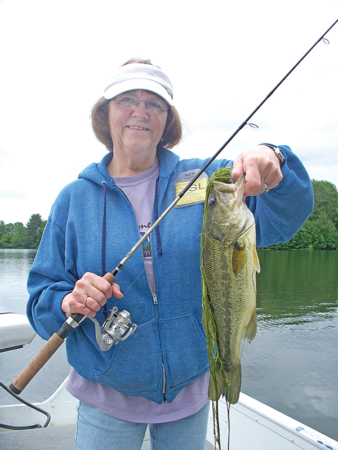Several weeks ago, I had the unique opportunity to teach a group of young people the art of bass fishing. The class of about 25 junior high and high school age kids were attending a week-long camp. Camp activities included a number of classes centered around bass biology, habitat and other related disciplines. My three-hour-long “bass fishing” class was conducted in a pavilion on the shores of what most of us refer to as Blanchard Dam.
I must say the whole idea of teaching a bunch of young kids all about bass fishing in three hours was a bit intimidating. It’s not that I’m afraid to get up in front of a group and talk about fishing stuff, but rather how could I possibly tell all about bass fishing in a mere three hours? After all, I’ve been talking about bass fishing for years in these columns, and I haven’t even come close to covering the subject.
For the greenhorn, probably one of the most intimidating things about learning to catch bass is what on earth do I put on the terminal end of my rig to bring on the action? To be honest, that can be somewhat intimidating even for the experienced bass guy.
When I went to the lake to teach my class, I lugged several large tackle boxes along as well as a number of smaller ones in hopes of showing some of the lures we bass fishermen like to use. The entire surface of the picnic table was covered, and I even left half my lures at home. While the kids were captivated by all the lures it was also apparent to me that I had to narrow my lure discussion down to a manageable level.
My advice, if you’re just getting into this business, is to keep it simple; carry a couple of lures for each of the categories or scenarios you will need to address. For example-a surface lure or two; concave faced lures and some with spinners fore and aft. Don’t expect surface lures to be at their best during the summer heat of midday but they might be the best choice early in the morning or late evening after things cool down. After dark can be the absolute best time to work a surface plug.
You should also have a couple of subsurface type lures such as the lipped minnow lures that dive and wobble when retrieved-some float and some have weight added to achieve greater depths when retrieved. In the soft bait, category are the paddletail minnow type lures that can be rigged a number of different ways.
Bass in mid-summer are often in deeper water through much of the day and to reach them you need a couple of lures that will quickly get to their level. Lead head jigs with any number of attachments are a good choice; plastic tubes, soft plastic grubs, plastic crayfish, or other creature baits are good choices. It’s also a good idea to have some of the jigs that are weedless or at least weed resistant. While we are in the soft plastics in wouldn’t hurt to have a small assortment of different sizes of plastic worms. These worms can be rigged a number of ways to make them weedless and trust me; they can be very effective. Don’t forget to add a couple of wacky rig worms as well.
This should be enough to get you well on your way but trust me if you are smitten with the bass fishing bug you are going to end up with a half-dozen tackle boxes full of lures like me and a lot of other bass fishing nuts.





Leave a Comment
Your email address will not be published. Required fields are marked with *